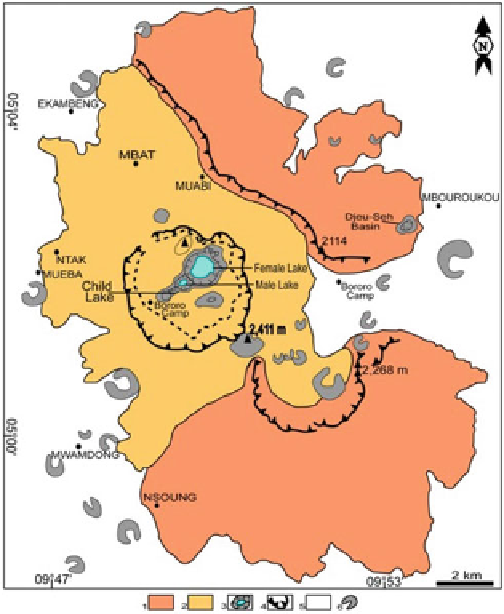Geology Reference
In-Depth Information
Fig. 3
Geological cross section of the Mt Manengouba (symbols are same as in Fig.
2
)
cones (Kagou Dongmo et al.
1998
) three-quarters of which
are broken (Figs.
5
and
6
). Broken cones result from lavas
that have erupted downslope of the pre-existing cones
composed of volcanic ejecta (bombs, cinders, scoria etc.).
The slope of a cone will slide under the in
uence of the
loose state of the volcanic ejecta (Kagou Dongmo
1998
).
fl
2.1.3 Crater Lakes
The Eboga caldera is characterized by two major crater lakes
(Female Lake and Male Lake). Female Lake (Fig.
7
) is the
larger one of the two, some 22 ha in area and 168 m
deep. Male Lake (Fig.
8
) is 2 ha in area and 92 m deep
(Kling
1988
). The temperature of the waters lakes varies
from 19.2 to 20.6
°
C and from 16.8 to 21
°
C, respectively
(Tanyileke
1994
).
Beside both lakes, in a SW
NE direction lays Child Lake
(Fig.
9
). This lake is shallow and seasonal. It is recharged
during the rainy season. During the dry season, the lake
-
oor
is inhabited by natural herbage. Child Lake is not closed like
Female Lake and Male Lake, and its outlet is visible in the
NW side of Fig.
9
.
In the Beme village (NW of Mt Manengouba), there is an
important circular crater lake (Fig.
10
). This lake is the
largest in the region, some 60 ha in area and 14.5 m deep
(Kling
1988
). It is characterized by steep rims that make
accessibility dif
fl
Fig. 4
The Mt Manengouba summit.
1
Elengoum volcano and its
caldera;
2
Eboga volcano and its caldera;
3
Crater lakes;
4
Caldera
boundaries;
5
Adventive phase
cult.
fl
ows;
6
Broken cones
2.1.4 Dome and Basin
Mt Manengouba slopes are characterized by several extrusive
domes (Kagou Dongmo
2006
) that have uneven topography.
The most scenic is the mugearite dome called Mboriko
(2,067 m altitude), situated in the Eboga caldera (Fig.
11
).
There is also a spectacular basin called Djeu-Seh (approxi-
mately 300 m in diameter and 70 m deep), located on the
eastern external slopes of the Elengoum caldera. While this
basin is not a lake, its bottom is swampy (Fig.
12
).
smaller Eboga caldera, which is well shaped and 4
-
5kmin
diameter. The
fl
oor of the Eboga caldera is slightly
fl
at and
approximately 1,900 m in relative relief.
2.1.2 Cones
Volcanic cones result from the accumulation of bombs,
ashes and lavas, ejected from the vents of a pre-existing
scoria cone (Costa
2011
). Mt Manengouba has around 70


